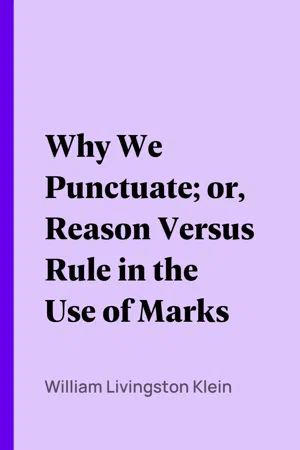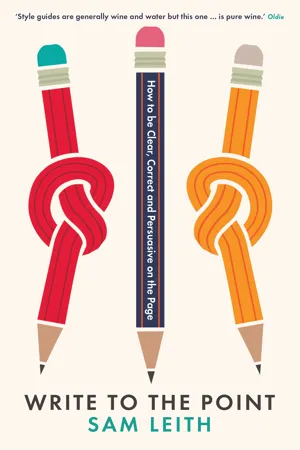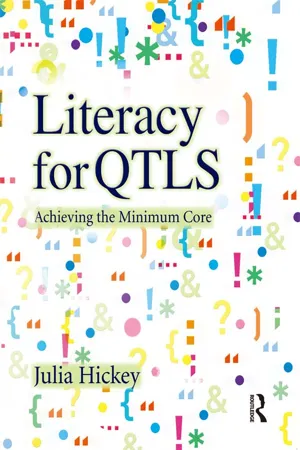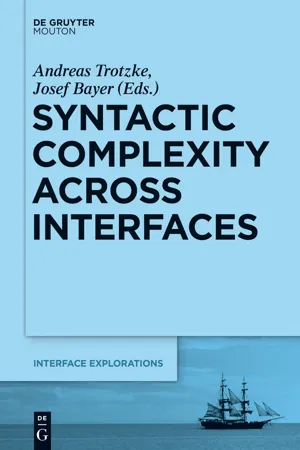Languages & Linguistics
Parentheses
Parentheses are punctuation marks used to enclose words, phrases, or clauses that are not essential to the meaning of a sentence. They are used to provide additional information or clarification, or to indicate an aside or an interruption in the main text. Parentheses are usually used in pairs and are marked by curved brackets.
Written by Perlego with AI-assistance
5 Key excerpts on "Parentheses"
- eBook - ePub
Science and Technical Writing
A Manual of Style
- Philip Rubens(Author)
- 2002(Publication Date)
- Routledge(Publisher)
Use Parentheses in pairs, ( ), when numbering items in a list within running text:After an error message, you have several options: (1) type “help!”; (2) type “x” or “X”; or (3) type “e” or “E”.4.131 If the house style is to cite references by numbers enclosed in Parentheses, use of a single parenthesis, instead of a pair, helps avoid confusion in numbering items:Burris (3) attributes this discrepancy to one of three factors: 1) the absorption influence identified by Johnson (4), 2) the wettability factor, or 3) the effect of high temperature on the system. Punctuating Parenthetical Comments
4.132 Do not place a period inside the closing parenthesis of a sentence in Parentheses inserted into another sentence:The reaction 2SO2 + O2 = 2SO3 (sulfuric acid is obtained by dissolving SO3 in water) occurs in the desired direction only at low temperatures. 4.133 A sentence enclosed by Parentheses but not placed in another sentence should end with a period inside the closing parenthesis; it should also begin with a capital letter:Hadrons are subatomic particles called quarks. (The word quark was adapted from a line in a novel written by James Joyce, Finnegans Wake. ) Murray Gell–Mann was . . . Brackets
4.134 Brackets set off an editorial interjection or parenthetical material within Parentheses. Editorial Interjections and Brackets
4.135 Use brackets to enclose editorial interjections within quoted matter:Robert Boyle told young scientists that they would likely “. . . meet with several observations and experiments which, though communicated for true by candid authors or undistrusted eye-witnesses, or perhaps recommended by your own experience [italics added], may, upon further trial, disappoint your expectation . . .” Parentheses within Parentheses
4.136 Use brackets to enclose a parenthetical remark within Parentheses:(We must still examine the mixture’s effects on several species [particularly, Ba, Cs, and Sr].) - William Livingston Klein(Author)
- 2014(Publication Date)
- Perlego(Publisher)
“Sic” is put in italics because this is the conventional way of writing most words from a foreign language. The words “are to,” being a suggested part of the text, are put in the text letter. Words thus supplied by the translators of the Bible are put in italics, simply to show their character, as is explained in the preface or elsewhere. Brackets are not used in the Bible text.Sometimes a line of poetry is too long for the type-measure in which the poem is set. If one or more words of such line are carried forward to make a new and very short line, the space between the full line above and the full line below such short line may be as wide as the space between two verses, and thus present a bad effect to the eye. To avoid this the extra word or words may be put in the line above, if the space permits, and at its end, with a single bracket at the left to cut it off from the preceding words in the same line.It is a common practice in legal and commercial work to enclose in Parentheses Arabic figures corresponding to the preceding number expressed in words. This practice often gives rise to a mistake that, when pointed out, is plain enough to anyone:117. Pay to John Smith or order twenty-five ($25.00) dollars.The matter in the Parentheses should be simply “25,” to correspond with what precedes; or the sentence should be written thus:117-1. Pay to John Smith or order twenty-five dollars ($25.00).When a woman signs her name to a letter, especially a letter to a stranger, and wishes to give other information than the name conveys, or to indicate how she should be addressed in a reply to her letter, Parentheses are used for the purpose:If she wishes simply to convey information as to whether she is a married or an unmarried woman, she uses the proper title, enclosed in Parentheses, before her name:118. Mary Louise Brown.118. (Mrs. George H. Brown. )119. (Miss) Mary Louise Brown .119-1. (Mrs.) Mary Louise Brown- eBook - ePub
Write to the Point
How to be Clear, Correct and Persuasive on the Page
- Sam Leith(Author)
- 2017(Publication Date)
- Profile Books(Publisher)
A good few words and set phrases, though many slightly archaic, come with apostrophes built in. They follow the same logic of the apostrophe marking omission. ‘E’en’ for ‘even’, ‘fo’c’sle’ for ‘forecastle’, ‘fish ’n’ chips’ for ‘fish and chips’.Brackets and their Friends
1. Round BracketsRound brackets, first of all, mark out Parentheses.* That is their day job. They hunt in pairs and they isolate material from the rest of the text around them, usually adding information that is incidental to the main meaning of the sentence. A very simple instance is:The cat (Henry) sat on the mat. The material in Parentheses can be as short as a word-fragment, or as long as a self-contained sentence.
The material in brackets can share the grammar of the main sentence, but doesn’t have to. Therefore:i. They decided to (re)consider my proposal. ii. I took the essential equipment (curling tongs, rubber gloves, a length of rope and a banjolele) for the job. iii. I had hoped that my lawyer would get me off on appeal (he was a graduate of a distinguished law school) but my hopes were disappointed. iv. There was nothing in the food cupboard when we got to the bothy. (The previous visitors must have cleaned it out.) He threw the bathwater (and the baby in it) away : the baby in brackets is the object of ‘threw’.OrHe threw the bathwater (there was still a baby in it) away: the bit in brackets is an independent clause.So the parenthetical material may or may not borrow grammatically from the sentence around it. The same freedom isn’t available when you reverse things. Whatever the material in brackets may be, and whatever form it takes, the sentence around it must be fully grammatical and self-contained in meaning without it. ‘The cat (and the dog) are sitting on the mat’ doesn’t work because if you take out the material in brackets you’re left with a singular subject and a plural verb. You can’t write: ‘The cat are sitting on the mat.’According to the same logic, punctuation belonging to the main sentence remains outside the brackets. So: - eBook - ePub
Literacy for QTLS
Achieving the Minimum Core
- Julia Hickey(Author)
- 2013(Publication Date)
- Routledge(Publisher)
A parenthesis is an extra piece of information included in a sentence. If the additional information is removed the sentence still makes sense. The additional information is separated from the main part of the sentence by punctuation:1.A pair of brackets – the opening (() and ()) closing brackets are the strongest way to signpost parenthesis. Brackets are often used when the writer wants to give directions and also when the additional information is virtually a sentence in its own right – it may well have a verb.2.A pair of commas – these are used when the additional information is closely linked to the content of the sentence.3.A pair of dashes – this indicator of parenthesis is quite informal. It signposts an interruption.There are no hard and fast rules as to which method you must choose to show parenthesis. The different kinds of punctuation marks used for parenthesis are summarised in Table 6.3 .Table 6.3 Hyphens, dashes and bracketsHyphen –• The hyphen is most commonly used to show words that belong together. This is part of the compound-word formation process: Short-sighted, colour-blind, three-quarters• Used to compound words in order to avoid vagueness or confusion within a sentence: The session was half-empty.• It can be used to add prefixes to words: co-opt• It is used to join broken words at the end of one line of writing leading to the next line.Checkpoints Check whether a word is fully compounded (requiring no hyphen), is at the hyphenated stage or consists of two words placed next to one another Three quarters or three-quarters are both acceptable. Be consistent. Try to avoid breaking a word at the end of a line.Dash —• The dash is used to interrupt a sentence with a phrase that doesn’t fit grammatically with the rest of the sentence. It identifies a secondary thought or additional information. It is quite informal. Learners used mind maps and flow charts – the session leant itself to the needs of learners with a visual learning preference - eBook - ePub
- Andreas Trotzke, Josef Bayer, Andreas Trotzke, Josef Bayer(Authors)
- 2015(Publication Date)
- De Gruyter Mouton(Publisher)
Marlies Kluck6 On representing anchored Parentheses in syntax
6.1 Introduction
Parentheses constitute a quirky class of constructions that are somehow interpolated in a regular sentence (the host or matrix clause). This ‘motley crew’ (Dehé and Kavalova 2007) ranges from unrelated utterances that are freely interjected in a sentence, to appositives, which clearly express information about a particular matrix constituent. We can more generally distinguish between ‘free’ (1) and ‘anchored’ (2) parenthesis:- (1) Free parenthesis
- Newton’s Principia – take a seat – was finally published in 1687.
[interjection ]
- Einstein’s theory of special relativity – I think – was presented in his 1905 paper.
[comment clause ]
- The professor made out with – and we all knew that – lots of students at the party.
[and -parenthetical ]
- Newton’s Principia – take a seat – was finally published in 1687.
- (2) Anchored parenthesis
- Bea kissed Bob, who she has known since high school, at the party.
[nominal appositive relative clause/NARC ]
- Bea kissed Bob, her high school sweetheart, at the party.
[nominal apposition/NA ]
- Bea kissed someone, I think it was Bob, at the party
[sluiced parenthetical ]
- Bea kissed [I think it was Bob] at the party.
[amalgam ]
- Bea kissed Bob, who she has known since high school, at the party.
Intuitively, there is a clear parallel between these interpolations: they all add some non-restrictive, secondary content to what is expressed by their hosts. However, the Parentheses in (1) are not related to anything specific in their hosts, whereas the ones in (2) all add information about a particular (understood) constituent in the host. That is, the Parentheses in both (2a), (2b) and (2c) provide extra, more specific information about Bob and someone . The construction in (2d) is an example of so-called sentence amalgamation (Lakoff 1974), and closely resembles the parenthetical in (2c). In this case however, the interpolation consists of a reduced it -cleft, of which the cleft pivot is associated with an null matrix argument, namely the understood object of kissed
Index pages curate the most relevant extracts from our library of academic textbooks. They’ve been created using an in-house natural language model (NLM), each adding context and meaning to key research topics.
Explore more topic indexes
Explore more topic indexes
1 of 6
Explore more topic indexes
1 of 4




